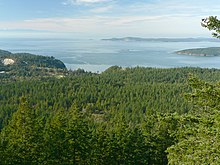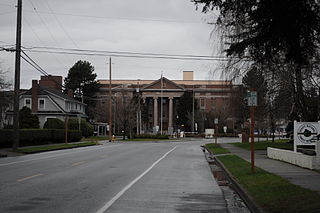
Skagit County is a county in the U.S. state of Washington. As of the 2020 census, the population was 129,523. The county seat and largest city is Mount Vernon. The county was formed in 1883 from Whatcom County and is named for the Skagit Indian tribe, which has been indigenous to the area prior to European-American settlement.

The Tulalip Tribes of Washington, formerly known as the Tulalip Tribes of the Tulalip Reservation, is a federally recognized tribe of Duwamish, Snohomish, Snoqualmie, Skagit, Suiattle, Samish, and Stillaguamish people. They are South and Central Coast Salish peoples of indigenous peoples of the Pacific Northwest Coast. Their tribes are located in the mid-Puget Sound region of Washington.

The Suquamish are a Lushootseed-speaking Native American people, located in present-day Washington in the United States. They are a southern Coast Salish people.

The Duwamish are a Lushootseed-speaking Southern Coast Salish people in western Washington, and the Indigenous people of metropolitan Seattle.

The LummiNation is a federally-recognized tribe of primarily Lummi people. The Lummi Nation also includes some Nooksack, Samish, and other local tribes which were removed to the reservation. It is based in the coastal area of the Pacific Northwest region of Washington state in the United States, and is located within the Bellingham Metropolitan Area

The Swinomishpeople are a historically Lushootseed-speaking Native American people in western Washington state in the United States. The Tribe lives in the southeastern part of Fidalgo Island in northern Puget Sound, near the San Juan Islands, in Skagit County, Washington. Skagit County is located about 70 miles (110 km) north of Seattle.
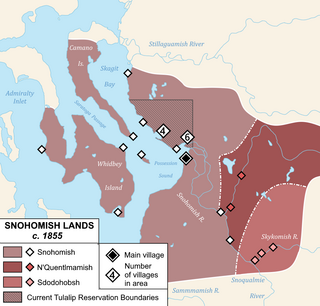
The Snohomish people are a Lushootseed-speaking Southern Coast Salish people who are indigenous to the Puget Sound region of Washington State. Most Snohomish are enrolled in the Tulalip Tribes of Washington and reside on the reservation or nearby, although others are enrolled in other tribes, and some are members of the non-recognized Snohomish Tribe of Indians. Traditionally, the Snohomish occupied a wide area of land, including the Snohomish River, parts of Whidbey and Camano Islands, and the nearby coastline of Skagit Bay and Puget Sound. They had at least 25 permanent villages throughout their lands, but in 1855, signed the Treaty of Point Elliott and were relocated to the Tulalip Reservation. Although some moved to the reservation, the harsh conditions, lack of land, and oppressive policies of the United States government caused many to leave.

Fidalgo Island is an island in Skagit County, Washington, located about 60 mi (97 km) north of Seattle. To the east, it is separated from the mainland by the Swinomish Channel, and from Whidbey Island to the south by Deception Pass. The island is named after the Spanish explorer and cartographer Salvador Fidalgo, who explored the area in 1790.

Guemes Island is a small island in western Skagit County, Washington, United States. It is located north of Fidalgo Island and the city of Anacortes, and is accessible by private boat and by the Guemes Island ferry operated by Skagit County.
The Samish are a Native American people who live in the U.S. state of Washington. They are a Central Coast Salish people. Through the years, they were assigned to reservations dominated by other Tribes, for instance, the Swinomish Indians of the Swinomish Reservation of Washington and the Tulalip Tribes of the Tulalip Reservation. They are also enrolled in the Samish Indian Nation, formerly known as the Samish Indian Tribe, which regained federal recognition in 1996.

Padilla Bay is a bay located in the U.S. state of Washington, between the San Juan Islands and the mainland. Fidalgo Island and Guemes Island lie to the west of Padilla Bay. Guemes Channel, between the islands, connects Padilla Bay to Rosario Strait. Samish Island lies to the north of Padilla Bay, beyond which is Samish Bay and Bellingham Bay.
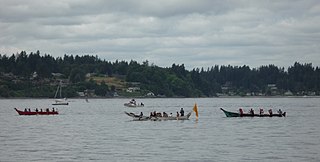
The Intertribal Canoe Journey is a celebrated event of the Indigenous peoples of the Pacific Northwest Coast. Organizers call it the Canoe Journey or Intertribal Canoe Journey, and colloqually Tribal Journeys. It is also referred to by its destination, i.e. Paddle to Muckleshoot.
The Lower Skagit are a tribe of the Lushootseed Native American people living in the U.S. state of Washington. Today they are enrolled in the federally recognized tribe, the Swinomish Indians of the Swinomish Reservation.

The Guemes Island ferry, the M/V Guemes, carries passengers and vehicles across Guemes Channel between Anacortes, Washington and Guemes Island. The ferry is operated by the Skagit County Public Works Department's Ferry Division.

The Swinomish Indian Tribal Community, also known as the Swinomish Tribe, is a federally recognized Tribe located on Puget Sound in Washington, United States. They are an Indigenous people of the Pacific Northwest that includes the Central and Coast Salish peoples who lived in the Samish and Skagit River valleys, nearby coasts, and islands. The Tribe's population includes Swinomish, Lower Skagit, Upper Skagit, Kikiallus, and Samish peoples.

The Port Gamble S'Klallam Tribe, formerly known as the Port Gamble Indian Community of the Port Gamble Reservation or the Port Gamble Band of S'Klallam Indians is a federally recognized tribe of S'Klallam people, located on the Kitsap Peninsula in Washington. They are an Indigenous peoples of the Northwest Coast.

The Mitchell Bay Band of the San Juan Islands is an indigenous Coast Salish community based in the San Juan Islands of Washington, United States. The community was first referred to as the Mitchell Bay Tribe by Office of Indian Affairs agent Charles Roblin in his 1919 Census of Unenrolled Indians, in reference to one of several bays with historically significant indigenous populations.
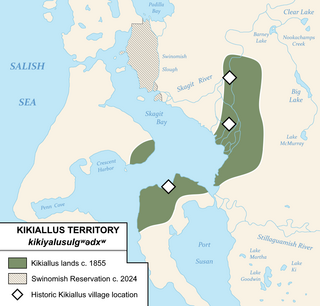
The Kikiallus people are a Lushootseed-speaking Coast Salish people Indigenous to parts of western Washington.
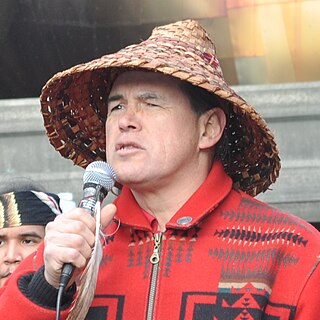
Brian Cladoosby is a Native American leader and activist. He served as chairman of the Swinomish Indian Tribal Community from 1997 to 2020 and was elected to his first of two terms as president of the National Congress of American Indians in October 2013. He previously served as president of the Affiliated Tribes of Northwest Indians.

The Lummi are a Central Coast Salish people Indigenous to western Washington, namely parts of the San Juan Islands and the mainland near what is now Bellingham, Washington.
